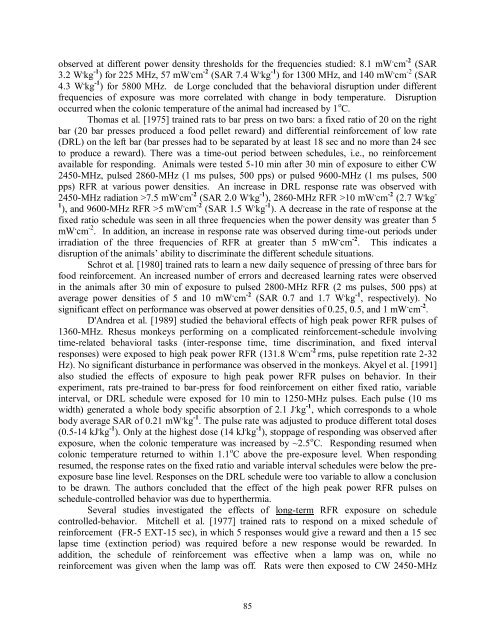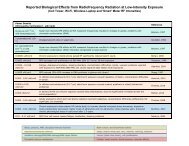Evidence for Effects on Neurology and Behavior - BioInitiative Report
Evidence for Effects on Neurology and Behavior - BioInitiative Report
Evidence for Effects on Neurology and Behavior - BioInitiative Report
You also want an ePaper? Increase the reach of your titles
YUMPU automatically turns print PDFs into web optimized ePapers that Google loves.
observed at different power density thresholds <str<strong>on</strong>g>for</str<strong>on</strong>g> the frequencies studied: 8.1 mW . cm -2 (SAR<br />
3.2 W . kg -1 ) <str<strong>on</strong>g>for</str<strong>on</strong>g> 225 MHz, 57 mW . cm -2 (SAR 7.4 W . kg -1 ) <str<strong>on</strong>g>for</str<strong>on</strong>g> 1300 MHz, <strong>and</strong> 140 mW . cm -2 (SAR<br />
4.3 W . kg -1 ) <str<strong>on</strong>g>for</str<strong>on</strong>g> 5800 MHz. de Lorge c<strong>on</strong>cluded that the behavioral disrupti<strong>on</strong> under different<br />
frequencies of exposure was more correlated with change in body temperature. Disrupti<strong>on</strong><br />
occurred when the col<strong>on</strong>ic temperature of the animal had increased by 1 o C.<br />
Thomas et al. [1975] trained rats to bar press <strong>on</strong> two bars: a fixed ratio of 20 <strong>on</strong> the right<br />
bar (20 bar presses produced a food pellet reward) <strong>and</strong> differential rein<str<strong>on</strong>g>for</str<strong>on</strong>g>cement of low rate<br />
(DRL) <strong>on</strong> the left bar (bar presses had to be separated by at least 18 sec <strong>and</strong> no more than 24 sec<br />
to produce a reward). There was a time-out period between schedules, i.e., no rein<str<strong>on</strong>g>for</str<strong>on</strong>g>cement<br />
available <str<strong>on</strong>g>for</str<strong>on</strong>g> resp<strong>on</strong>ding. Animals were tested 5-10 min after 30 min of exposure to either CW<br />
2450-MHz, pulsed 2860-MHz (1 ms pulses, 500 pps) or pulsed 9600-MHz (1 ms pulses, 500<br />
pps) RFR at various power densities. An increase in DRL resp<strong>on</strong>se rate was observed with<br />
2450-MHz radiati<strong>on</strong> >7.5 mW . cm -2 (SAR 2.0 W . kg -1 ), 2860-MHz RFR >10 mW . cm -2 (2.7 W . kg -<br />
1 ), <strong>and</strong> 9600-MHz RFR >5 mW . cm -2 (SAR 1.5 W . kg -1 ). A decrease in the rate of resp<strong>on</strong>se at the<br />
fixed ratio schedule was seen in all three frequencies when the power density was greater than 5<br />
mW . cm -2 . In additi<strong>on</strong>, an increase in resp<strong>on</strong>se rate was observed during time-out periods under<br />
irradiati<strong>on</strong> of the three frequencies of RFR at greater than 5 mW . cm -2 . This indicates a<br />
disrupti<strong>on</strong> of the animals’ ability to discriminate the different schedule situati<strong>on</strong>s.<br />
Schrot et al. [1980] trained rats to learn a new daily sequence of pressing of three bars <str<strong>on</strong>g>for</str<strong>on</strong>g><br />
food rein<str<strong>on</strong>g>for</str<strong>on</strong>g>cement. An increased number of errors <strong>and</strong> decreased learning rates were observed<br />
in the animals after 30 min of exposure to pulsed 2800-MHz RFR (2 ms pulses, 500 pps) at<br />
average power densities of 5 <strong>and</strong> 10 mW . cm -2 (SAR 0.7 <strong>and</strong> 1.7 W . kg -1 , respectively). No<br />
significant effect <strong>on</strong> per<str<strong>on</strong>g>for</str<strong>on</strong>g>mance was observed at power densities of 0.25, 0.5, <strong>and</strong> 1 mW . cm -2 .<br />
D'Andrea et al. [1989] studied the behavioral effects of high peak power RFR pulses of<br />
1360-MHz. Rhesus m<strong>on</strong>keys per<str<strong>on</strong>g>for</str<strong>on</strong>g>ming <strong>on</strong> a complicated rein<str<strong>on</strong>g>for</str<strong>on</strong>g>cement-schedule involving<br />
time-related behavioral tasks (inter-resp<strong>on</strong>se time, time discriminati<strong>on</strong>, <strong>and</strong> fixed interval<br />
resp<strong>on</strong>ses) were exposed to high peak power RFR (131.8 W . cm -2 rms, pulse repetiti<strong>on</strong> rate 2-32<br />
Hz). No significant disturbance in per<str<strong>on</strong>g>for</str<strong>on</strong>g>mance was observed in the m<strong>on</strong>keys. Akyel et al. [1991]<br />
also studied the effects of exposure to high peak power RFR pulses <strong>on</strong> behavior. In their<br />
experiment, rats pre-trained to bar-press <str<strong>on</strong>g>for</str<strong>on</strong>g> food rein<str<strong>on</strong>g>for</str<strong>on</strong>g>cement <strong>on</strong> either fixed ratio, variable<br />
interval, or DRL schedule were exposed <str<strong>on</strong>g>for</str<strong>on</strong>g> 10 min to 1250-MHz pulses. Each pulse (10 ms<br />
width) generated a whole body specific absorpti<strong>on</strong> of 2.1 J . kg -1 , which corresp<strong>on</strong>ds to a whole<br />
body average SAR of 0.21 mW . kg -1 . The pulse rate was adjusted to produce different total doses<br />
(0.5-14 kJ . kg -1 ). Only at the highest dose (14 kJ . kg -1 ), stoppage of resp<strong>on</strong>ding was observed after<br />
exposure, when the col<strong>on</strong>ic temperature was increased by ~2.5 o C. Resp<strong>on</strong>ding resumed when<br />
col<strong>on</strong>ic temperature returned to within 1.1 o C above the pre-exposure level. When resp<strong>on</strong>ding<br />
resumed, the resp<strong>on</strong>se rates <strong>on</strong> the fixed ratio <strong>and</strong> variable interval schedules were below the preexposure<br />
base line level. Resp<strong>on</strong>ses <strong>on</strong> the DRL schedule were too variable to allow a c<strong>on</strong>clusi<strong>on</strong><br />
to be drawn. The authors c<strong>on</strong>cluded that the effect of the high peak power RFR pulses <strong>on</strong><br />
schedule-c<strong>on</strong>trolled behavior was due to hyperthermia.<br />
Several studies investigated the effects of l<strong>on</strong>g-term RFR exposure <strong>on</strong> schedule<br />
c<strong>on</strong>trolled-behavior. Mitchell et al. [1977] trained rats to resp<strong>on</strong>d <strong>on</strong> a mixed schedule of<br />
rein<str<strong>on</strong>g>for</str<strong>on</strong>g>cement (FR-5 EXT-15 sec), in which 5 resp<strong>on</strong>ses would give a reward <strong>and</strong> then a 15 sec<br />
lapse time (extincti<strong>on</strong> period) was required be<str<strong>on</strong>g>for</str<strong>on</strong>g>e a new resp<strong>on</strong>se would be rewarded. In<br />
additi<strong>on</strong>, the schedule of rein<str<strong>on</strong>g>for</str<strong>on</strong>g>cement was effective when a lamp was <strong>on</strong>, while no<br />
rein<str<strong>on</strong>g>for</str<strong>on</strong>g>cement was given when the lamp was off. Rats were then exposed to CW 2450-MHz<br />
85



